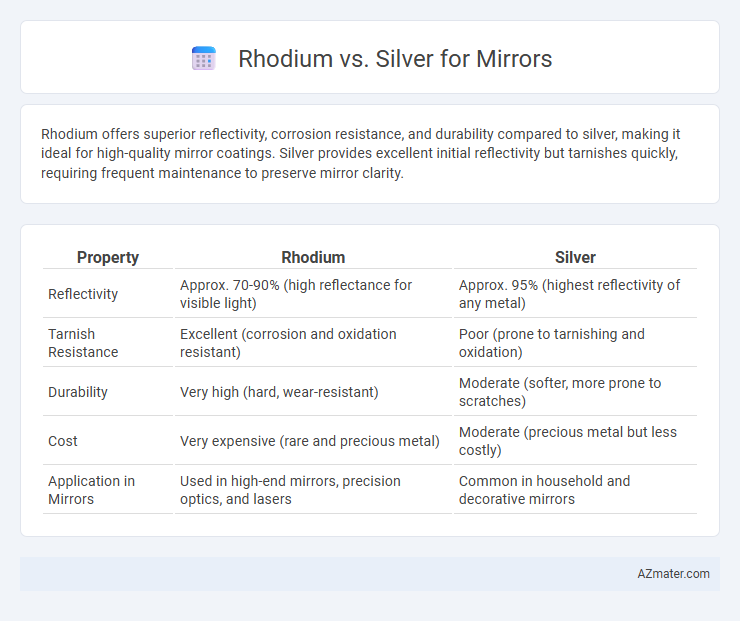Rhodium offers superior reflectivity, corrosion resistance, and durability compared to silver, making it ideal for high-quality mirror coatings. Silver provides excellent initial reflectivity but tarnishes quickly, requiring frequent maintenance to preserve mirror clarity.
Table of Comparison
| Property | Rhodium | Silver |
|---|---|---|
| Reflectivity | Approx. 70-90% (high reflectance for visible light) | Approx. 95% (highest reflectivity of any metal) |
| Tarnish Resistance | Excellent (corrosion and oxidation resistant) | Poor (prone to tarnishing and oxidation) |
| Durability | Very high (hard, wear-resistant) | Moderate (softer, more prone to scratches) |
| Cost | Very expensive (rare and precious metal) | Moderate (precious metal but less costly) |
| Application in Mirrors | Used in high-end mirrors, precision optics, and lasers | Common in household and decorative mirrors |
Introduction to Rhodium vs Silver Mirrors
Rhodium mirrors offer superior reflectivity and corrosion resistance compared to silver mirrors, making them ideal for high-precision optical applications. While silver mirrors provide excellent reflectance in the visible spectrum, they are more susceptible to tarnishing and oxidation, reducing their long-term durability. Rhodium's high hardness and chemical stability ensure enhanced performance in harsh environments, setting it apart for specialized mirror coatings.
Historical Use of Silver in Mirrors
Silver has been the preferred material for mirror-making since the 16th century due to its high reflectivity and availability, making it the cornerstone of traditional mirror production. Despite its susceptibility to tarnishing, silver mirrors provide superior image clarity and brightness compared to many alternatives. Rhodium, introduced later as a durable coating, offers enhanced corrosion resistance and longevity but remains less historically significant than silver in the evolution of mirror technology.
Emergence of Rhodium as a Mirror Coating
Rhodium has emerged as a superior mirror coating compared to silver due to its exceptional durability, resistance to tarnishing, and high reflectivity across a broad spectrum of light. Unlike silver, which easily oxidizes and degrades over time, rhodium maintains clarity and brightness in mirrors used in high-end optics and luxury applications. Advances in thin-film deposition techniques have increased rhodium's accessibility and performance, making it a preferred choice for premium mirror coatings in scientific instruments and decorative finishes.
Reflectivity Comparison: Rhodium vs Silver
Rhodium exhibits a reflectivity of approximately 70% to 90% across visible light wavelengths, making it highly durable and resistant to tarnish compared to silver. Silver offers superior peak reflectivity, reaching up to 98% in visible light, providing the brightest and most mirror-like finish available. Despite silver's higher reflectivity, rhodium's resistance to oxidation and corrosion makes it a preferred choice for long-lasting, high-performance mirror surfaces in harsh environments.
Durability and Tarnish Resistance
Rhodium offers superior durability compared to silver, making it an excellent choice for mirror surfaces that require long-lasting protection. Its remarkable tarnish resistance ensures mirrors maintain their reflective clarity without frequent polishing or maintenance. Silver, while initially bright and reflective, tends to tarnish over time due to exposure to air and sulfur compounds, reducing its longevity and aesthetic appeal.
Cost Analysis: Rhodium versus Silver
Rhodium plating costs significantly more than silver, with prices often ranging from $700 to $1,000 per ounce compared to silver's $25 to $30 per ounce, influencing overall mirror production expenses. The higher expense is offset by rhodium's superior durability, corrosion resistance, and reflective properties, extending mirror lifespan and reducing maintenance costs. Silver offers excellent initial reflectivity at a much lower cost but tarnishes quickly, requiring frequent cleaning and recoating, which can increase total long-term costs.
Aesthetic Differences and Visual Clarity
Rhodium mirrors offer a cooler, more reflective surface with a subtle bluish-white sheen, enhancing visual clarity and providing a striking, modern aesthetic compared to the warmer, softer glow of silver mirrors. Silver mirrors excel in delivering a natural, true-to-color reflection with high reflectivity but can develop tarnish over time, impacting clarity and appearance. Rhodium's superior resistance to oxidation maintains long-term brilliance and sharpness, making it ideal for applications demanding sustained visual precision and a sleek, contemporary look.
Applications in Modern Optics and Decor
Rhodium offers superior reflectivity and corrosion resistance, making it ideal for high-performance mirrors used in advanced optical instruments and lasers. Silver provides excellent reflectance in visible light spectra but requires protective coatings to prevent tarnishing, commonly applied in decorative mirrors and architectural elements. In modern optics and decor, rhodium's durability enhances precision applications, while silver remains favored for its cost-effectiveness and aesthetic appeal.
Maintenance Requirements for Rhodium and Silver Mirrors
Rhodium mirrors exhibit superior durability and resist tarnishing, requiring minimal maintenance compared to silver mirrors, which are prone to oxidation and need frequent polishing to maintain their reflective quality. Silver mirrors demand regular cleaning with specialized anti-tarnish agents to prevent dullness caused by exposure to air and moisture. Rhodium's hardness and chemical inertness significantly reduce the need for upkeep, making it ideal for long-term mirror applications where sustained clarity and low maintenance are critical.
Choosing the Right Mirror Material: Rhodium or Silver
Rhodium mirrors offer superior corrosion resistance and exceptional reflectivity, making them ideal for high-precision optical applications and environments prone to tarnish. Silver mirrors provide unmatched reflectance in the visible spectrum but require protective coatings due to their susceptibility to oxidation and tarnishing over time. Selecting between rhodium and silver for mirrors depends on balancing long-term durability and maintenance needs with the desired reflectivity and cost constraints.

Infographic: Rhodium vs Silver for Mirror
 azmater.com
azmater.com